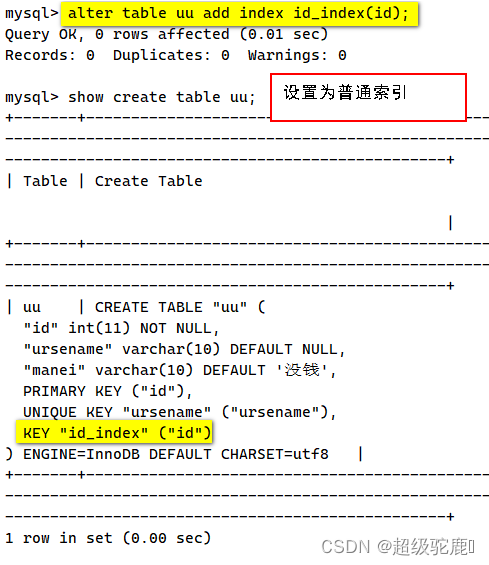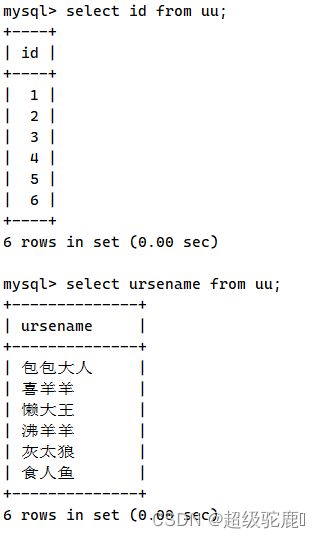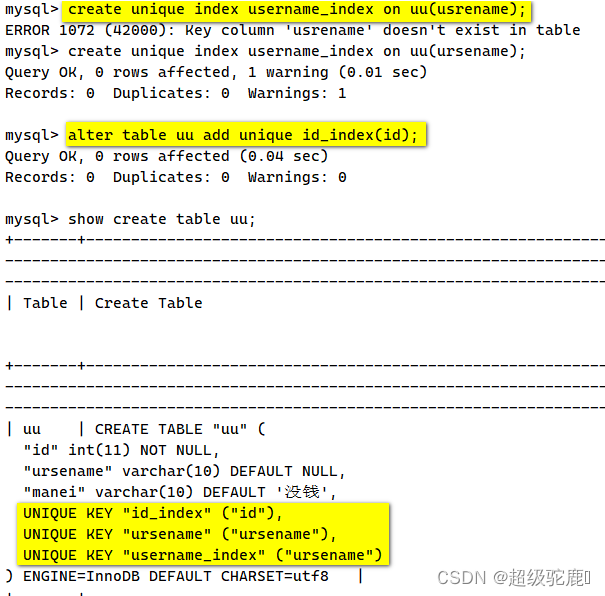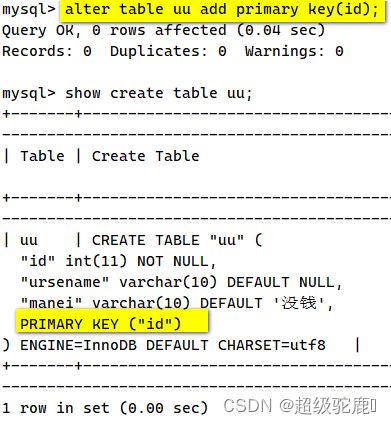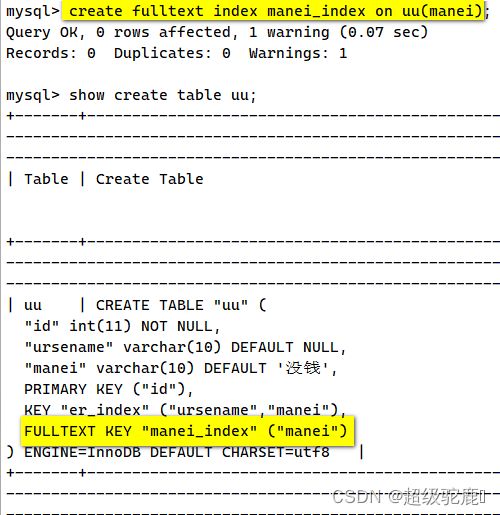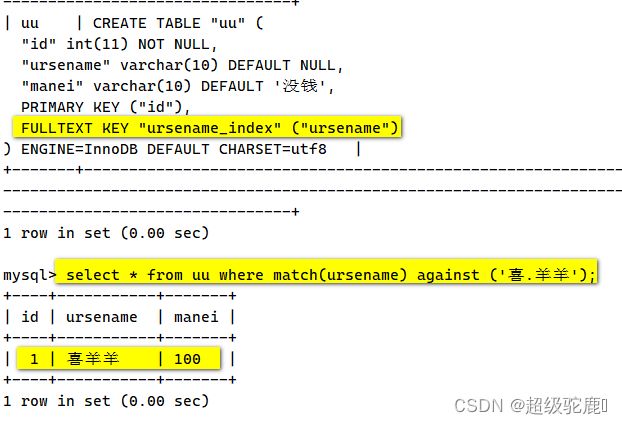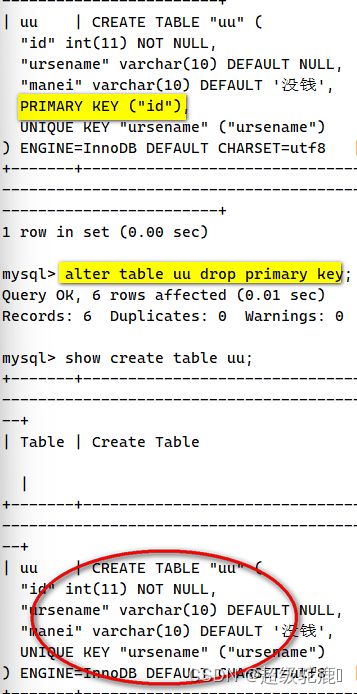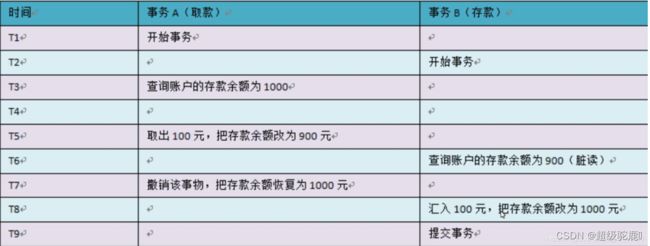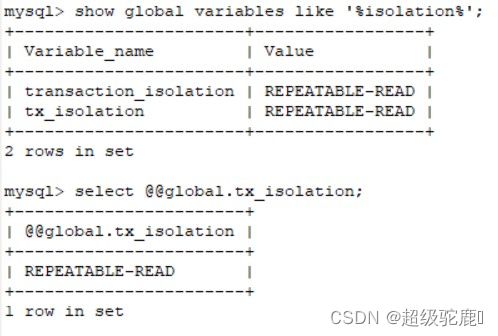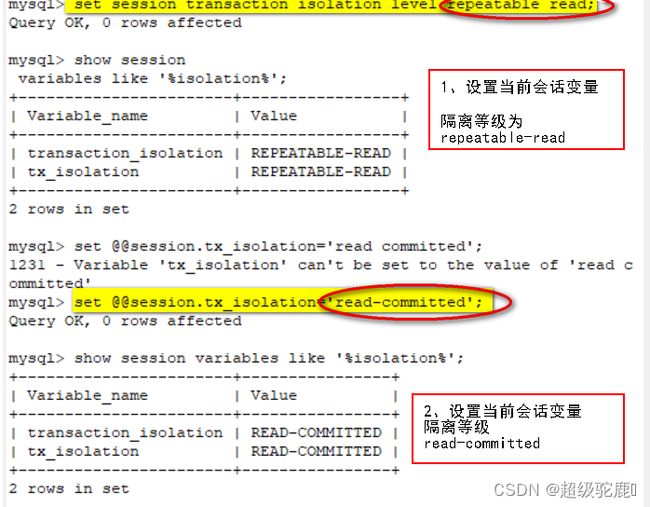MySQL 索引与事务
MySQL 索引相关知识详解与事务的详解
- 一、索引的概念
- 二、索引的作用
-
- 索引的副作用
- 三、索引是如何实现的
- 四、创建索引的原则依据
- 五、索引的优缺点
-
- 1、优点
- 2、缺点
- 六、索引的分类和创建
-
- 1、普通索引
- 2、唯一索引
- 3、主键索引
- 4、组合索引
- 5、全文索引
- 七、索引的查看
- 八、索引的删除
-
- 1、直接删除索引
- 2、修改表方式删除索引
- 3、删除主键索引
- EXPLAIN
- MySQL事务
-
- 一、事务的概念
- 二、事务的ACID特点
-
- 1、原子性
- 2、一致性
- 3、隔离性
- 4、持久性(Durability)
- 总结
- 三、事务之间的相互影响
-
- 1、脏读
- 2、不可重复读
- 3、幻读
- 4、丢失更新
- 四、Mysql及事物隔离级别
- 1、查询全局事务隔离级别
- 2、查询会话事务隔离级别
- 3、设置全局事务隔离级别
- 4、设置会话事务隔离级别
- 五、事务控制语句
-
- 1、测试提交事务
- 2、测试回滚事务
- 3、测试多点回滚
- 4、使用 set 设置控制事务
一、索引的概念
- 索引是一个排序的列表,在这个列表中存储着索引的值和包含这个值的数据所在行的物理地址。
- 使用索引后可以不用扫描全表来定位某行的数据,而是先通过索引表找到该行数据对应的物理地址然后访问相应的数据,因此能加快数据库的查询速度。
- 索引就好比是一本书的目录,可以根据目录中的页码快速找到所需的内容。
- 索引是表中一列或者若干列值排序的方法。
- 建立索引的目的是加快对表中记录的查找或排序。
二、索引的作用
- 设置了合适的索引之后,数据库利用各种快速定位技术,能够大大加快查询速度,这是创建所有的最主要的原因。
- 当表很大或查询涉及到多个表时,使用索引可以成千上万倍地提高查询速度。
- 可以降低数据库的IO成本,并且索引还可以降低数据库的排序成本。
- 通过创建唯一性索引,可以保证数据表中每一行数据的唯一性。
- 可以加快表与表之间的连接。
- 在使用分组和排序时,可大大减少分组和排序的时间。
总结一句话就是索引的作用就是加快对表中记录的查找和排序
索引的副作用
- 索引需要占用额外的磁盘空间。
- 对于 MyISAM 引擎而言,索引文件和数据文件是分离的,索引文件用于保存数据记录的地址。
- 而 InnoDB 引擎的表数据文件本身就是索引文件。
- 在插入和修改数据时要花费更多的时间,因为索引也要随之变动。
三、索引是如何实现的
- 没有索引的情况下,要查询某行数据,需要先扫描全表来定位某行数据
- 有索引后会通过查找条件的字段值找到其索引对应的行数据的物理地址,然后根据物理地址访问相应的数据
四、创建索引的原则依据
索引随可以提升数据库查询的速度,但并不是任何情况下都适合创建索引。因为索引本身会消耗系统资源,在有索引的情况下,数据库会先进行索引查询,然后定位到具体的数据行,如果索引使用不当,反而会增加数据库的负担。
- 表的主键、外键必须有索引。因为主键具有唯一性,外键关联的是子表的主键,查询时可以快速定位。
- 记录数超过300行的表应该有索引。如果没有索引,需要把表遍历一遍,会严重影响数据库的性能。
- 经常与其他表进行连接的表,在连接字段上应该建立索引。
- 唯一性太差的字段不适合建立索引。
- 更新太频繁地字段不适合创建索引。
- 经常出现在 where 子句中的字段,特别是大表的字段,应该建立索引。
- 索引应该建在选择性高的字段上。
- 索引应该建在小字段上,对于大的文本字段甚至超长字段,不要建索引。
五、索引的优缺点
1、优点
- 设置了合适的索引之后,数据库利用各种快速定位技术,能够大大加快查询速度,这是创建所有的最主要的原因。
- 当表很大或查询涉及到多个表时,使用索引可以成千上万倍地提高查询速度。
- 可以降低数据库的IO成本,并且索引还可以降低数据库的排序成本。
- 通过创建唯一性索引,可以保证数据表中每一行数据的唯一性。
- 可以加快表与表之间的连接。
- 在使用分组和排序时,可大大减少分组和排序的时间。
2、缺点
- 索引需要占用额外的磁盘空间。
- 对于 MyISAM 引擎而言,索引文件和数据文件是分离的,索引文件用于保存数据记录的地址。
- 而 InnoDB 引擎的表数据文件本身就是索引文件。
- 在插入和修改数据时要花费更多的时间,因为索引也要随之变动。
六、索引的分类和创建
索引可分为5类
- 普通索引
- 唯一索引
- 主键索引
- 组合索引
- 全文索引
创建方法
- 直接创建索引(主键索引无法使用此方式)
- 修改表结构方式添加索引
1、普通索引
最基本的索引类型,没有唯一性之类的限制
直接创建索引
create index 索引名 on 表名 (列名[(length)]);
(列名[(length)]:length 为可选项,如果忽略 length 的值,则使用整个列的值作为索引。
如果指定使用列的前 length 个字符来创建索引,这样有利于减小索引文件的大小。
索引名建议以 “index” 结尾。
修改表方式创建
alter table 表名 add index 索引名 (列名);
例:alter table member add index id_index (id);
select id from member;
select id,name from member;
2、唯一索引
- 与普通索引类似,但区别是唯一索引列的每一个值都唯一。
- 唯一索引允许有空值(注意和主键不同)。
- 如果是用组合索引创建,则列值得组合必须唯一。
- 添加唯一键将自动创建唯一索引。
直接创建唯一索引
create unique index 索引名 on 表名 (列名);
例:select * from member;
create unique index address_index on member (address);
create unique index name_index on member (name);
show create table member;
修改表方式创建
alter table 表名 add unique 索引名 (列名);
例:alter table member add unique cardid_index (cardid);
3、主键索引
- 是一种特殊的唯一索引,必须指定为“PRIMARY KEY”。
- 一个表只能有一个主键,不允许有空值。 添加主键将自动创建主键索引。
修改方式创建索引
alter table 表名 add primary key (列名);
创建表的时候指定索引
create table 表名 (字段1 数据类型,字段2 数据类型,primary key (列名));
例:create table test1 (id int primary key,name varchar(20));
create table test2 (id int,name varchar(20),primary key (id));
show create table test1;
show create table test2;
4、组合索引
- 可以是单列上创建的索引,也可以是在多列上创建的索引。
- 需要满足最左原则,因为select语句的 where 条件是依次从左往右执行的,所以在使用 select 语句查询时 where 条件使用的字段顺序必须和组合索引中的排序一致,否则索引将不会生效。
修改表方式创建组合索引
alter table 表名 add index 索引名(列名);
创建表的时候指定组合索引
create index 索引名 on 表名 (字段1 数据类型,字段2 数据类型);
5、全文索引
- 适合在进行模糊查询的时候使用,可用于在一篇文章中检索文本信息。
- 在 MySQL5.6 版本以前 fulltext 索引仅可用于 MyISAM 引擎,在 5.6 版本之后 innodb 引擎也支持 fulltext 索引。
- 全文索引可以在 char、varchar 或者 text 类型的列上创建。每个表只允许有一个全文索引。
直接创建索引
create fulltext index 索引名 on 表名 (列名);
修改表方式指定全文索引
alter table 表名 add fulltext 索引名 (列名);
创建表的时候指定全文索引
create table 表名 (字段1 数据类型,字段2 数据类型,fulltext 索引名 (列名));
#数据类型可以为 CHAR、VARCHAR 或者 TEXT
使用全文索引查询
SELECT * FROM 表名 WHERE MATCH(列名) AGAINST('查询内容');
例:select * from member where match(remark) against('this is vip');
七、索引的查看
show index from 表名;
show index from 表名\G 竖向显示表索引信息
show keys from 表名;
show keys from 表名\G
各字段的含义如下:
| Table | 表的名称 |
|---|---|
| Non_unique | 如果索引不能包括重复词,则为 0;如果可以,则为 1 |
| Key_name | 索引的名称 |
| Seq_in_index | 索引中的列序号,从 1 开始 |
| Column_name | 列名称 |
| Collation | 列以什么方式存储在索引中。在 MySQL 中,有值‘A’(升序)或 NULL(无分类) |
| Cardinality | 索引中唯一值数目的估计值 |
| Sub_part | 如果列只是被部分地编入索引,则为被编入索引的字符的数目。如果整列被编入索引,则为 NULL |
| Packed | 指示关键字如何被压缩。如果没有被压缩,则为 NULL |
| Null | 如果列含有 NULL,则含有 YES。如果没有,则该列含有 NO |
| Index_type | 用过的索引方法(BTREE, FULLTEXT, HASH, RTREE) |
| Comment | 备注 |
八、索引的删除
1、直接删除索引
drop index 索引名 on 表名;
例:drop index name_index on member;
2、修改表方式删除索引
alter table 表名 drop index 索引名;
例:alter table member drop id_index;
show index from member;
3、删除主键索引
alter table 表名 drop primary key;
EXPLAIN
- 通过explain分析和优化,explain显示了mysql如何使用索引来处理select语句以及连接表
explain一些相关的参数:
- possible_keys:显示可能应用在这张表中的索引。
- key:实际使用的索引。如果为NULL,则没有使用索引。
- key_len:使用的索引的长度。(在不损失精确性的情况下,长度越短越好。)
- ref:显示索引的哪一项被使用了,如果可能,则是一个常数。
- Extra:关于MySQL如何解析查询的额外信息。
MySQL事务
一、事务的概念
- 是一种机制、一个操作序列,包含了一组数据库操作命令,并且把所有的命令作为一个整体一起向系统提交或撤销操作请求,即这一组数据库命令要么都执行,要么都不执行
- 是一个不可分割的工作逻辑单元,在数据库系统上执行并发操作,事务是最小的控制单元
- 适用于多用户同时操作的数据录系统的场景,如银行、保险公司及证券交易系统等等
- 通过事务的整体性以保证数据的一致性
- 说白了,所谓事务,它是一个操作序列,这些操作要么都执行,要么都不执行,它是一个不可分割的工作单位
二、事务的ACID特点
- ACID,是指在可靠数据库管理系统(DBMS)中,事务(transaction)应该具有的四个特性:原子性(Atomicity)、一致性(Consistency)、隔离性(Isolation)、持久性(Durability)。这是可靠数据库所应具备的几个特征。
1、原子性
指事务是一个不可再分割的工作单位,事务中的操作要么都发生,要么都不发生
- 事务中的所有元素必须作为一个整体提交或回滚
- 如果事务中的任何元素失败,则整个事务将失败
- 案例
- A给B转账100元钱的时候只执行了扣款语句,就提交了,此时如果突然断电,A账号已经发生了扣款,B账号却没有收到加款,在生活中就会引起纠纷。这种情况就需要事务的原子性来保证事务要么执行,要么就不执行。
2、一致性
指的事务开始之前和事务结束以后,数据库的完整性约束没有被破坏。
- 当事务完成时,数据必须处于一致状态
- 在事务开始前,数据库中存储的数据处于一致状态
- 在正在进行的事务中,数据可能处于不一致的状态
- 当事务成功时,数据必须再次回到已知的一致状态
- 案例
- 对银行转账事务,不管事务成功还是失败,应该保证事务结束后,表中A和B的存款总额跟事务执行前一致
3、隔离性
指在并发环境中,当不同的事务同时操纵相同的数据时,每个事务都有各自的完整的数据空间
- 对数据进行修改的所有并发事务是彼此隔离的,表明事务必须是独立的,它不应以任何方式依赖于或影响其他事务(直接影响)
- 修改数据的事务可在另一个使用相同数据的事务开始之前访问这些数据,或者在另一个使用相同数据的事务结束之后访问这些数据
4、持久性(Durability)
在事务完成以后,该事务所对数据库所作的更改便持久的保存在数据库之中,并不会被回滚。
- 指不管系统是否发生故障,事务处理的结果都是永久的
- 一旦事务被提交,事务的效果会被永久地保留在数据库中
总结
在事务管理中,原子性是基础,隔离性是手段,一致性是目的,持久性是结果
三、事务之间的相互影响
事务之间的相互影响分为几种,分别为:
1、脏读
- 一个事务读取了另一个事务未提交的数据,而这个数据是有可能回滚的。
2、不可重复读
- 一个事务内两个相同的查询却返回了不同数据。这是由于查询时系统中其他事务修改的提交而引起的。
3、幻读
- 个事务对一个表中的数据进行了修改,这种修改涉及到表中的全部数据行。同时,另一个事务也修改这个表中的数据,这种修改是向表中插入一行新数据。那么,操作前一个事务的用户会发现表中还有没有修改的数据行,就好象发生了幻觉一样。
4、丢失更新
- 两个事务同时读取同一条记录,A先修改记录,B也修改记录(B不知道A修改过),B提交数据后B的修改结果覆盖了A的修改结果。
四、Mysql及事物隔离级别
| 隔离 | 说明 | 效果 |
|---|---|---|
| read uncommitted | 读取尚未提交的数据 | 不解决脏读 |
| read committed | 读取已经提交的数据 | 可以解决脏读 |
| repeatable read | 重复读取 | 可以解决脏读 和 不可重复读 —mysql默认的 |
| serializable | 串行化 | 可以解决 脏读 不可重复读 和 虚读—相当于锁表 |
1、查询全局事务隔离级别
show global variables like '%isolation%';
select @@global.tx_isolation;
2、查询会话事务隔离级别
show session variables like '%isolation%';
select @@session.tx_isolation;
3、设置全局事务隔离级别
set global transaction isolation level read committed;
set @@global.tx_isolation='read committed'
4、设置会话事务隔离级别
set session transaction isolation level repeatable read;
set @@session.tx_isolation='read committed';
五、事务控制语句
BEGIN 或 START TRANSACTION:显式地开启一个事务。
COMMIT 或 COMMIT WORK:提交事务,并使已对数据库进行的所有修改变为永久性的。
ROLLBACK 或 ROLLBACK WORK:回滚会结束用户的事务,并撤销正在进行的所有未提交的修改。
SAVEPOINT S1:使用 SAVEPOINT 允许在事务中创建一个回滚点,一个事务中可以有多个 SAVEPOINT;“S1”代表回滚点名称。
ROLLBACK TO [SAVEPOINT] S1:把事务回滚到标记点。
案列
create database csgo;
use csgo;
create table class(
id int(10) primary key not null,
name varchar(40),
money double
);
insert into class values(1,'A',1000);
insert into class values(2,'B',1000);
select * from class;
1、测试提交事务
begin;
update class set money= money -100 where name='A';
select * from class;
commit;
quit
mysql -uroot -pabc123
use csgo;
select * from class;
2、测试回滚事务
begin;
update class set money= money +100 where name='A';
select * from class;
rollback;
quit
mysql -u root -p
use csgo;
select * from class;
3、测试多点回滚
begin;
update class set money= money +100 where name='A';
select * from class;
savepoint S1; #设置回滚点
update class set money= money +100 where name='B';
select * from class;
savepoint S2; #设置回滚点
insert into class values(3,'C',1000);
select * from class;
rollback to savepoint S1; 回到回滚点一当时的状态
select * from class;
4、使用 set 设置控制事务
set autocommit=0; #禁止自动提交
set autocommit=1; #开启自动提交,Mysql默认为1
show variables like 'autocommit'; #查看Mysql中的AUTOCOMMIT值
- 如果没有开启自动提交,当前会话连接的mysql的所有操作都会当成一个事务直到你输入rollback|commit;当前事务才算结束。当前事务结束前新的mysql连接时无法读取到任何当前会话的操作结果。
- 如果开起了自动提交,mysql会把每个sql语句当成一个事务,然后自动的commit。
当然无论开启与否,begin; commit|rollback; 都是独立的事务。

